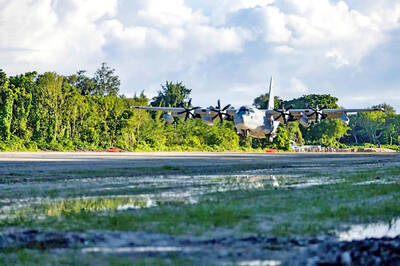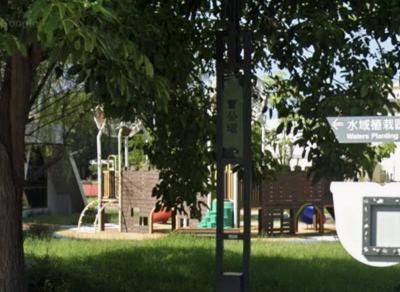China has demonstrated that it has the ability to seize air supremacy over areas west of the first island chain and is gradually gaining the ability to take control of the Taiwan Strait, a report published yesterday by the Ministry of National Defense (MND) said.
The Chinese military’s intelligence, monitoring and reconnaissance capabilities cover areas west of the second island chain in the western Pacific, and is enough to support all sorts of military actions within the region, the ministry said in its five-year military development plan submitted to the legislature.
Chinese bombers and fighter jets have regularly been crossing the first island chain into the western Pacific, which constitutes a direct challenge to the US’ military presence in the Asia-Pacific region and demonstrates China’s ability to achieve air supremacy in areas west of the island chain, the report said.
The first island chain comprises Taiwan, the Kuril Islands, the Japanese archipelago, the Ryukyu Islands, the northern Philippines and Borneo, while the second island chain comprises the Bonins, the Marianas, Guam and the Palau archipelago.
The island chain strategy was first mentioned in 1951 by US foreign policy commentator John Foster Dulles during the Korean War. It is often used in political and military analyses of China’s military movements in the western Pacific.
China has been conducting far-sea training, using its first operational aircraft carrier, the Liaoning, as part of efforts to gradually improve its ability to take control of the Taiwan Strait, the report said.
Meanwhile, the Chinese army has been sharpening its preparedness against Taiwan via landing drills and has developed the ability to seize Taiwan’s outlying islands, the report said.
It said that China has short and medium-range missiles that can reach any part of Taiwan and is developing long-range missiles capable of countering foreign military forces.
In another annual report on China’s military power, the ministry said that in the period between Aug. 18 last year to Aug. 9, Chinese military aircraft skirted the nation’s air defense identification zone 16 times during their far-sea flight drills in a bid to intimidate Taiwan.
Between Dec. 25 last year and July 12, the Liaoning conducted four drills in the waters near Taiwan, including in the Strait, the report added.
It said any military action by China against Taiwan is likely to take the form of deterrence, blockade and live fire involving all branches of its armed services.
China might also increase its non-traditional combat operations, such as cyberattacks and electronic warfare, it said.
It also outlined seven scenarios that could lead to China’s use of force against Taiwan, starting with Taiwan declaring independence, moving unequivocally toward independence, facing domestic unrest or acquiring nuclear weapons.
The other three factors were a delay in cross-strait dialogue on peaceful unification, foreign intervention into Taiwan’s internal affairs and foreign military presence in Taiwan.

The inspection equipment and data transmission system for new robotic dogs that Taipei is planning to use for sidewalk patrols were developed by a Taiwanese company, the city’s New Construction Office said today, dismissing concerns that the China-made robots could pose a security risk. The city is bringing in smart robotic dogs to help with sidewalk inspections, Taipei Deputy Mayor Lee Ssu-chuan (李四川) said on Facebook. Equipped with a panoramic surveillance system, the robots would be able to automatically flag problems and easily navigate narrow sidewalks, making inspections faster and more accurate, Lee said. By collecting more accurate data, they would help Taipei

TAKING STOCK: The USMC is rebuilding a once-abandoned airfield in Palau to support large-scale ground operations as China’s missile range grows, Naval News reported The US Marine Corps (USMC) is considering new sites for stockpiling equipment in the West Pacific to harden military supply chains and enhance mobility across the Indo-Pacific region, US-based Naval News reported on Saturday. The proposed sites in Palau — one of Taiwan’s diplomatic allies — and Australia would enable a “rapid standup of stored equipment within a year” of the program’s approval, the report said, citing documents published by the USMC last month. In Palau, the service is rebuilding a formerly abandoned World War II-era airfield and establishing ancillary structures to support large-scale ground operations “as China’s missile range and magazine

A 72-year-old man in Kaohsiung was sentenced to 40 days in jail after he was found having sex with a 67-year-old woman under a slide in a public park on Sunday afternoon. At 3pm on Sunday, a mother surnamed Liang (梁) was with her child at a neighborhood park when they found the man, surnamed Tsai (蔡), and woman, surnamed Huang (黃), underneath the slide. Liang took her child away from the scene, took photographs of the two and called the police, who arrived and arrested the couple. During questioning, Tsai told police that he had met Huang that day and offered to

A British man was arrested for attempting to smuggle 14.37kg of marijuana into Taiwan through Taiwan Taoyuan International Airport, Taipei Customs said late yesterday. The man, who arrived from Bangkok at 9pm on Friday, was asked by customs officers to open his luggage during a random inspection, Taipei Customs said in a news release. The passenger, whose identity was not disclosed, refused to open his suitcase and tried to flee the restricted area. He was eventually subdued by three customs officials and an Aviation Police Bureau officer. A later search of his checked luggage uncovered 14.37kg of marijuana buds. The case was handed over